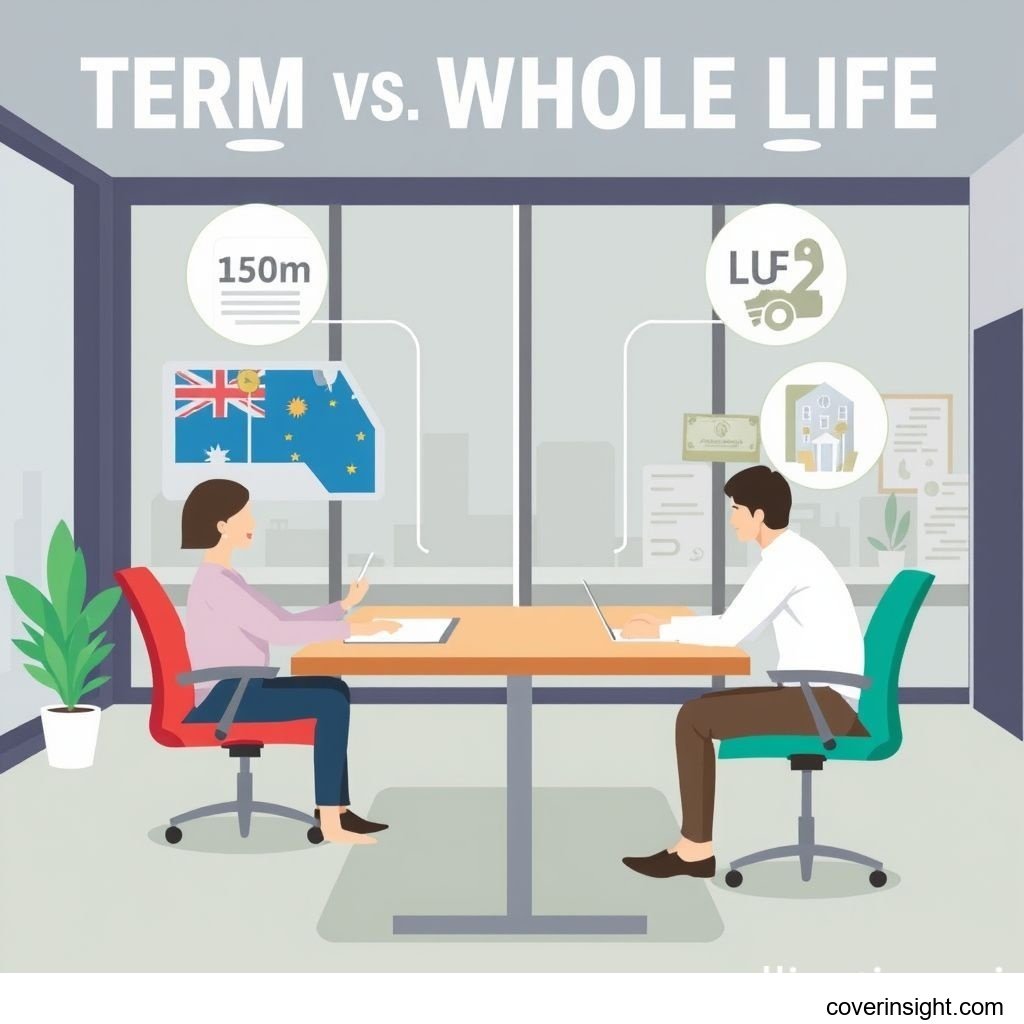Term vs Whole Life AU: Smart Choice for 2025
Introduction
Navigating the world of life insurance can feel a bit like wading through treacle, especially when you're trying to make a smart financial decision for 2025. In Australia, the choice between term life and whole life insurance is a big one, impacting not just your hip pocket but also the financial security of your loved ones down the track. It's not a 'one size fits all' situation, so understanding the nuances of term vs whole life AU is absolutely crucial. We're here to help you get your head around it, ensuring you make the best call for your circumstances.
Coverage Details
What’s Included
When you’re looking at life insurance in Australia, the core difference between term and whole life lies in their structure and what they're designed to do.
Term Life Insurance (Term Life AU): This type of policy is straightforward: it provides coverage for a specific period, or "term" – think 10, 20, or even 30 years. If you pass away within that term, your beneficiaries receive a lump sum payment. It's pure protection, with no savings or investment component. Once the term ends, the policy expires, and you'd need to renew it (often at a higher premium) or let it lapse. It’s often the go-to for covering specific financial obligations like a mortgage or when your children are young and dependent.
Whole Life Insurance (Whole Life AU): As the name suggests, whole life insurance covers you for your entire life, provided premiums are paid. Beyond just offering a death benefit, it also accumulates a cash value over time, which can be a real game-changer for some. This cash value grows on a tax-deferred basis, and you can often borrow against it or even surrender the policy for its cash value later on. This combination of lifelong protection and a savings element makes it a more complex, and generally more expensive, option.
Common Exclusions
While both types of policies offer vital protection, it’s fair dinkum to know what they generally won't cover. Common exclusions for both term and whole life insurance often include:
-
Suicide: Typically excluded if it occurs within a specified initial period (e.g., 13 months) of the policy's commencement or reinstatement.
-
Illegal Activities: Death resulting directly from participation in a criminal act.
-
Dangerous Hobbies/Occupations: If not disclosed and underwritten upfront, death from certain high-risk activities (like extreme sports or certain hazardous professions) might be excluded. It's always best to be upfront about these from the get-go.
-
Material Misrepresentation: Providing false or incomplete information during the application process can lead to a claim being denied. Honesty is the best policy, always.
-
Pre-existing Conditions: Conditions not declared or accepted by the insurer at the time of application may be excluded.
Cost Analysis
Price Factors
The cost of your life insurance premium, whether for term vs whole life AU, isn't just plucked out of thin air. Several key factors come into play, shaping what you’ll pay:
-
Age: Generally, the younger you are when you take out a policy, the lower your premiums will be. It's a no-brainer, really – younger folks are seen as less risky.
-
Health and Lifestyle: Your current health, medical history, smoking status, and even your occupation or hobbies (especially if they involve risk) will significantly influence your premium. A healthy lifestyle can definitely save you a few bob.
-
Sum Insured: The higher the payout you want your beneficiaries to receive, the more you'll pay in premiums. It's all about balancing protection with affordability.
-
Policy Term (for Term Life): A longer term for a term life policy typically means higher premiums as the risk period for the insurer is extended.
-
Cash Value Component (for Whole Life): The main reason whole life insurance is considerably more expensive than term life is the integrated savings/investment component. You're essentially paying for lifelong coverage and a growing asset.
-
Riders and Add-ons: Any extra benefits you add, like total and permanent disability (TPD) cover or critical illness cover, will naturally increase your premium.
Saving Tips
Looking to get a good deal without compromising on protection? No worries, here are a few tips:
-
Shop Around: Don’t just go with the first quote. Compare options from various insurers to find the best value for your "Term vs Whole Life AU 2025: Your Smart Cost Guide." Websites that compare multiple providers can be a real lifesaver here.
-
Prioritise Your Needs: Before you even look at costs, figure out exactly what you need coverage for. Do you need to cover a mortgage, replace income, or leave an inheritance? This clarity will help you avoid over-insuring.
-
Maintain Good Health: Keeping fit and healthy isn’t just good for you; it's good for your wallet too. Quitting smoking or managing chronic conditions can lead to lower premiums.
-
Consider a Shorter Term (for Term Life): If your primary goal is to cover specific debts (like a mortgage) that will be paid off in a certain number of years, a shorter term policy might be more cost-effective than a longer one.
-
Bundle Policies: Sometimes, insurers offer discounts if you bundle multiple policies, such as life insurance with home or car insurance. It's always worth asking.
-
Regular Review: Life changes! What suited you five years ago might not suit you today. Regularly review your policy to ensure it still aligns with your needs and budget. For more general advice, you might find useful "Insurance Resources Global".
FAQs
How much does term vs whole life AU cost?
Typically, term life insurance is significantly more affordable than whole life insurance. This is because term life offers pure protection for a limited period, while whole life provides lifelong coverage and includes a cash value component that grows over time, making it a more complex and feature-rich product.
What affects premiums?
Premiums are primarily affected by your age, health status (including medical history and smoking habits), the amount of coverage you choose (sum insured), and for term life, the length of the policy term. For whole life, the investment component also plays a big role in its higher cost.
Is it mandatory?
No, life insurance is not mandatory in Australia. Unlike compulsory third-party (CTP) car insurance, obtaining life insurance is a personal choice based on individual financial circumstances and family needs. However, it's often a smart move, especially if you have dependents or significant debts. You can find more information about Australian insurance generally on "AU Insurance Home".
How to choose?
Choosing between term and whole life insurance boils down to your specific financial goals, budget, and life stage. If you need coverage for a defined period (e.g., while raising a family or paying off a mortgage) and want the most affordable option, term life is often the better fit. If you're looking for lifelong coverage with a savings component and can afford higher premiums, whole life might be for you. It's often a good idea to chat with a financial advisor to tailor a solution to your unique situation.
Consequences of no coverage?
Without adequate life insurance, your family could be left in a bit of a pickle financially if you were to pass away unexpectedly. This could mean struggling to cover ongoing living expenses, mortgage repayments, children's education costs, or even final expenses like funeral costs. According to data from the Australian Prudential Regulation Authority, a significant portion of Australian households remain underinsured, highlighting the critical need for adequate protection to avoid such hardships.
Consider Sarah, a 35-year-old nurse from Perth with two young children. She initially thought whole life insurance was the bees' knees, offering a savings component. However, after consulting a financial advisor, she realised a more affordable term life policy allowed her to secure substantial coverage for her working years, ensuring her kids' education and mortgage were covered should the worst happen. She put the savings from the lower premiums into a separate investment vehicle, giving her more flexibility. It just goes to show, what works for one person might not be the go for another. The Insurance Council of Australia also provides valuable resources for consumers navigating the insurance landscape.
Author Insight & Experience
As someone who's seen firsthand the financial struggles families face when unexpected events hit, choosing the right life insurance isn't just a financial decision; it's about peace of mind. Based on my experience living in AU, it often comes down to balancing immediate budget constraints with long-term protection goals. Don't just pick one off the shelf; take the time to figure out what truly fits your mob, because when life throws you a curveball, knowing your loved ones are looked after is worth its weight in gold.









Comments